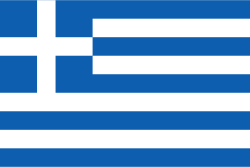Galatsi flower delivery
Send a bouquet of happy gerberas or a luxurious arrangement with gorgeous red roses to your loved ones in Galatsi and celebrate with them. Trust our online store for fast and safe delivery of your gift.
82 Results
Show filters
Sort:
Price
0 € - 50 €
50 € - 100 €
100 € - 200 €
200 € +
Color
Red
White
Colorful
Pink
Green
Fuchsia
Purple
Blue
Yellow
Cream
Orange
Lilac
Bicolor
Black
Containers
Ceramic
Glass
Basket
Box
Self watering pot
Wooden
Chest
Metallic
Flowers
Roses
Chrysanthemums
Gerberas
Lillies
Tulips
Alstroemerias
Amaryllis
Orchid flowers
Orchid dendrobium
Mixed flowers
Sunflowers
Gifts
Gifts for her
Balloons
Chocolates
Decorative gifts
Arrangements with drinks
Gourmet basket
Greeting cards
Jewelry
Gifts for children
Gifts for him
Spirits
Gift sets
Gift sets | wines and chocolates
Occasion
Anniversary
Apology
Birthday
Business gift
Christening
Congratulations
Easter
Engagement
Father's day
Funeral
Get well soon
Just because
Mother's day
Name day
New year
Newborn baby boy
Newborn baby girl
Opening
Love and romance
Surprise
Thank you
Valentine's day
Wedding
Woman's day
Christmas
Plants
Flowering plants
Green plants
Indoor plants
Plant arrangements
Orchid plants
Dracaena
Φυτά για Επαγγελματικούς Χώρους
Poinsettia plant
Bonsai
Seasons
Seasonal flowers
Winter flower
Spring flowers
A few words about Galatsi
Galatsi is a northern suburb of Athens, Greece, and a municipality of the Attica region and borders with Nea Ionia, with Filothei and Paleo Psychiko, and with the Municipality of Athens.
Although several etymologies have been proposed about the origin of the name Galatsi, it originates from the surname of Symeon Galakis, a squire who purchased lands around the church of Agia Glykeria in 1851. Consequently, the whole area was given his name, which, according to the phenomenon featuring the old Athenian phonology and known as tsitakism, was pronounced 'Galatsis', thus the name of the area was finally Galatsi. An alternative theory suggests that it derived from gala, the Greek word for the milk that the shepherds of the area's rangelands yelled hovering around in order to sell their products.
Galatsi until 1850 was an uninhabited area with the name Eumorfi Ekklisia (Omorfokklisia) from the homonymous church of the area. Then the first inhabitants of Fokida began to arrive, who build temporary houses, to spend the summer with their herds.
But the first permanent residents came in the 1910s mainly, as kiln workers. Workers from the Cyclades, Crete, Macedonia and elsewhere work in them. The people of Naxos and the Cretans, who arrive to work in Galatsi, build their houses around the kilns. Soon shops appear there to serve them and thus the first neighbourhoods are created.
During the German occupation, the Germans chose the area of Grava as their camp, while at the water refinery they carried out executions. Turkovounia is used by both the conquerors and the guerrillas, who turn it into a hideout. The mountain remains inaccessible even during the war. The Occupation and the needs of the Athenians for fuel led most of the forest to destruction.
Sights worth visiting in Galatsi!
Omorfokklisia (Beautiful church)
The Omorfokklisia is a 12th-century church in an area known for its peace and calmness. This church dedicated to Saint George is considered one of the landmarks of the area.
Church of Agia Glykeria
It was built in 1590 by Osia Filothei and for more than 300 years it was used as girls' school, monastery and secret school. It was demolished in 1927 to build the current church on the same site. Agia Glykeria is the patron saint of Galatsi.
Veikou Park
Veikou Park is a huge area of greenery and is one of the largest green lungs in Athens. It has a cafeteria, playground, stadiums, theatre, summer cinema and is an attraction for many Athenians on weekends.
Gravas school complex
Gravas School Complex is the most famous and largest school complex in Athens, as are many other educational foundations and public and private institutes.
Turkovounia and Attiko Alsos
Turkovounia, with a maximum altitude of 337m., is the highest hill within the urban complex of Athens. It is a rocky hill range, at the western foot of which Galatsi extends. The main body of Turkovouni is located on the border of Galatsi with the Municipality of Athens, on which there is the Attiko Alsos, a forest of significant ecological value for the whole basin, which is a popular recreation area for Athenians because of the view and functions it offers.
Galatsi today is a sophisticated city, densely populated, but also with several green spaces, concentrated around its hills. It is a pole of attraction for the Athenians due to the grove of Veikos and Turkovounia, the various cultural events, but also unique monuments such as the Omorfokklisia and the picturesque lime kilns.





